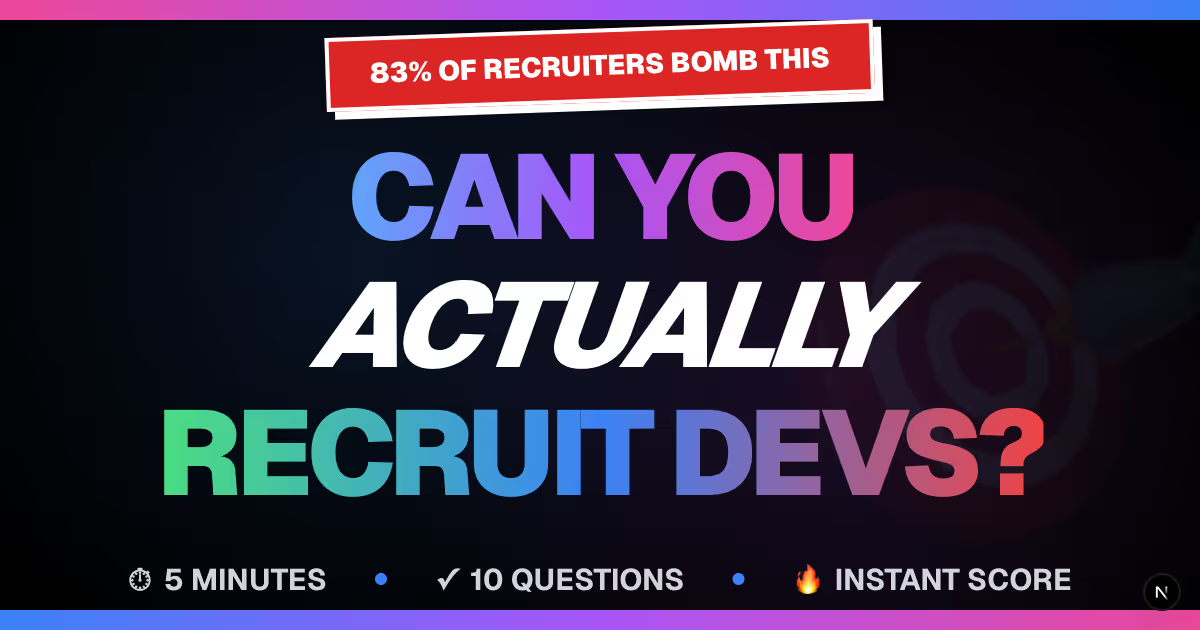


Explore why developers abandon recruitment funnels and discover strategies to enhance engagement and streamline hiring processes.
Developers are walking away from hiring processes - and it's no surprise.
The tech recruitment system is riddled with inefficiencies that push candidates away. From lengthy hiring steps to irrelevant job descriptions, poor communication, and mismatched expectations, these issues make 90% of developers ignore traditional outreach efforts. Ghosting, fake job postings, and trivia-based interviews only add to the frustration, leaving companies with unqualified candidates and empty pipelines.
What’s the fix?
- Simplify processes: Clear timelines, fewer steps, and upfront role details.
- Better communication: No ghosting, consistent updates, and tailored messaging.
- Accurate job descriptions: Focus on skills, responsibilities, and growth opportunities.
- Developer-first platforms: Use trusted spaces like daily.dev to connect with engaged talent.
Building trust and respect into every step of recruitment is the only way to keep developers interested and engaged.
5 Key Recruitment Funnel Metrics to Boost Talent Acquisition
Main Reasons Developers Drop Out of Recruitment Funnels
Understanding why developers abandon recruitment processes is key to improving outdated hiring practices. These issues often highlight deeper flaws in how companies approach technical talent. Let’s explore the main reasons developers disengage at various stages of the recruitment funnel.
Long or Complicated Hiring Processes
Developers place a high value on efficiency and straightforward processes. When hiring involves multiple screening rounds without a clear purpose or schedule, it can quickly erode trust. Many companies fail to set expectations upfront, leaving candidates blindsided by additional, unplanned steps. This lack of clarity wastes time and leaves a negative impression.
Poor or Inconsistent Communication
Communication breakdowns are a fast track to losing strong candidates. Ghosting - when recruiters or hiring managers stop responding - remains a common complaint. On top of that, conflicting information about the role or timeline creates confusion and portrays the company as disorganized.
Vague or Mismatched Job Descriptions
Ambiguous job descriptions are a major turn-off. When postings lack key technical details or fail to explain the role clearly, developers struggle to determine if the position aligns with their skills and career goals. Worse, some candidates prepare for interviews only to find that the actual responsibilities are entirely different from what was advertised. This disconnect wastes time for everyone involved.
Generic Recruitment Experiences
Developers often receive generic, impersonal outreach, particularly with the rise of AI-driven messaging. These cookie-cutter approaches fail to address the unique needs of technical professionals. Personalized and transparent interactions are essential to making developers feel valued.
Misalignment Between Skills and Job Requirements
One of the most frustrating experiences for developers is encountering roles that don’t match their skills. Trivia-based interviews that focus on theoretical questions instead of practical problem-solving are a prime example. As Nimrod Kramer noted on September 29, 2025, "The silent killer of recruiting is mismatched expectations with hiring managers." Miscommunication between recruiters, hiring managers, and candidates often leads to disappointment. Similarly, irrelevant skills tests signal a disconnect in how companies evaluate technical expertise.
Addressing these challenges is crucial to creating recruitment processes that resonate with developers and keep them engaged throughout the hiring journey.
How to Keep Developers Engaged in Recruitment Funnels
To tackle the challenges of complexity and disconnection in developer recruitment, it's essential to focus on a developer-first approach. This means respecting their time, being transparent, and building trust from the very first interaction.
Simplify the Application Process
Start by making the application process as straightforward as possible. Share detailed role information upfront, including the technical stack, team structure, and potential growth opportunities. A double opt-in system works wonders here, ensuring only genuinely interested candidates move forward.
"Developers see full context upfront, so the ones who engage already know the role fits their expectations." - daily.dev Recruiter
This approach has shown to boost reply rates to an impressive 85–90%. By pre-qualifying candidates, you eliminate unnecessary steps like initial screenings and jump straight into meaningful conversations. When developers have already reviewed the role and opted in, you skip the awkward cold pitch phase entirely. Integrating this process with your ATS can also streamline candidate management and reduce friction on the backend. The result? Clearer communication and more personalized follow-ups.
Improve Communication with Developers
Developers value their time and expertise, so communication needs to reflect that. Instead of resorting to generic, mass outreach, focus on presenting tailored opportunities to developers whose skills and interests align with the role. Let them engage only when they’re genuinely interested.
"Every intro comes from a developer who reviewed your role and chose to engage - not someone you had to chase." - daily.dev Recruiter
This opt-in model avoids pushy tactics that often alienate developers. Be transparent about timelines, interview stages, and role expectations. Address potential mismatches early by using custom screening questions that assess criteria not always covered in public job descriptions. Internally, recruiters and hiring managers must stay aligned to ensure accurate and consistent information, which helps build trust and avoids confusion.
Craft Job Descriptions Developers Actually Want to Read
Generic, jargon-heavy job descriptions won’t cut it. Developers respond better to clear, concise descriptions that outline technical details and role expectations. Highlight the challenges they’ll tackle and the opportunities available.
Include specifics like the technical stack, architecture decisions they’ll influence, and the types of problems they’ll solve. Mention processes like code reviews, deployment practices, and collaboration tools. Developers also want to know whether they’ll be working on legacy systems or building new projects from scratch.
Don’t forget to include perks like mentorship programs, conference budgets, or opportunities to lead technical initiatives. Be realistic about requirements - distinguish between essential skills and "nice-to-haves" to avoid alienating potential candidates.
Leverage Developer-Focused Recruitment Platforms
Traditional recruitment methods often feel intrusive, especially for developers who aren’t actively job hunting. Platforms designed for developers offer a more natural and trust-based way to connect.
For example, daily.dev Recruiter helps employers engage with developers in their professional spaces. With its warm, double opt-in introductions, developers never feel spammed, and recruiters only interact with candidates who have chosen to engage.
sbb-itb-d1e6221
Building Better Recruitment Funnels for Developers
Creating recruitment funnels that resonate with developers requires a thoughtful, data-driven approach. The goal is to design systems that respect developers' time while uncovering areas for improvement in the process.
Track and Analyze Drop-Off Rates
Pinpointing where developers exit your recruitment funnel is essential to identifying and addressing weak spots. Start by tracking engagement at every stage - from the initial job posting views to the final offer acceptance.
Analyzing drop-off rates can reveal specific friction points. Metrics like time-to-response, interview completion rates, and feedback quality can highlight where candidates lose interest. For instance, if developers frequently drop out after technical interviews, your assessments might be too lengthy or misaligned with their expectations. Similarly, if candidates disengage after initial conversations, your job descriptions might not accurately reflect the role.
Adding custom screening questions can provide deeper insights. These questions help validate candidates against hiring manager criteria not covered in the job description. When developers invest effort into detailed responses, it demonstrates genuine interest and helps identify what keeps them engaged. These insights can guide targeted improvements based on real candidate experiences.
Make Changes Based on Feedback
Drop-off metrics are just the beginning - developer feedback is crucial for refining your recruitment funnel. However, collecting feedback needs to be simple and worthwhile for candidates to participate.
"What's broken about developer hiring? What we heard, what needs to change" – Nimrod Kramer, daily.dev
Common frustrations include trivia-based interviews, ghosting, vague job roles, fake postings, and irrelevant AI-driven noise. Gathering feedback through surveys or direct engagement with developer communities can shed light on these issues. For example, if ghosting is a recurring complaint, introducing clear communication protocols with defined response timelines can help address it.
"The silent killer of recruiting is mismatched expectations with hiring managers" – Nimrod Kramer, daily.dev
Feedback loops should lead to actionable changes. When developers share constructive criticism - whether about interview formats or communication gaps - document their input, share it with your team, and track whether these adjustments reduce future drop-offs.
Use Developer-First Platforms for Recruitment
Traditional recruitment methods often create unnecessary friction, discouraging developers before meaningful conversations can even begin. Developer-first platforms integrate recruitment into spaces where developers already spend their time.
One example is daily.dev Recruiter, which connects employers with developers through a vibrant professional network. This platform engages over 1,000,000 developers daily and has logged more than 1 billion developer sessions. Such active participation underscores the value of meeting developers where they are.
The key to this approach is building trust. Developers are more likely to engage with opportunities presented in environments they already trust. For instance, daily.dev boasts a 4.8 rating from over 2,500 reviews and has been named "Product of the Year", reflecting the strong trust developers place in this platform.
"Trust is the currency of modern recruiting" – Nimrod Kramer, daily.dev
Developer-first platforms prioritize warm, double opt-in introductions instead of cold outreach. This means developers choose to engage with opportunities based on genuine interest. Notably, 90% of daily.dev's network doesn't respond to traditional recruitment methods. Additionally, 40% of the network consists of senior individual contributors and leaders, ensuring access to highly experienced candidates while minimizing drop-offs.
Finally, these platforms often integrate with existing Applicant Tracking Systems (ATS), streamlining workflows, maintaining consistent communication, and preventing administrative gaps that can lead to disengagement. By leveraging platforms developers already trust, you can create a smoother, more effective recruitment funnel tailored to their needs.
Conclusion: Creating a Developer-Focused Recruitment Strategy
A well-thought-out recruitment strategy tailored for developers is entirely achievable by addressing common pain points.
Key reasons developers drop out of recruitment funnels include drawn-out hiring processes, lack of clear communication, job descriptions that don’t reflect their skills or aspirations, and impersonal recruitment experiences. These issues can be resolved by focusing on transparency, efficiency, and relevance.
Start by building trust right from the first interaction. Simplify the application process, maintain consistent communication, and make sure job descriptions align with the technical expertise and goals of the developers you’re targeting. Beyond that, connect with developers in spaces they already trust and enjoy. This approach not only attracts talent but also fosters long-term engagement.
Platforms designed with developers in mind can make a huge difference. For instance, daily.dev Recruiter offers a unique way to connect with developers through warm, double opt-in introductions. This ensures both parties are genuinely interested, eliminating the frustration of cold outreach and creating a more meaningful recruitment experience.
FAQs
How can companies effectively communicate with developers during the hiring process?
To connect well with developers, companies need to focus on being clear and relevant. Start by sharing straightforward, detailed information about the role, what’s expected, and what the company culture is like. This helps everyone stay on the same page from the beginning.
Tools like daily.dev Recruiter can make a big difference. They give developers a complete picture of the opportunity, ensuring they only engage if they’re genuinely interested. This way, you build trust while simplifying the process for both developers and recruiters.
How can companies create job descriptions that attract the right developers and accurately represent the role?
When crafting job descriptions that appeal to developers, focus on being clear, relevant, and straightforward. Start by clearly outlining the role's responsibilities, the skills required, and how the developer's work will contribute to the team or product. Steer clear of vague terms or overly technical jargon that might confuse or discourage potential candidates.
Include meaningful details about your company, such as the team they’ll join, the tools and technologies they’ll be working with, and what makes your workplace stand out. Highlight aspects that make the role attractive - whether it’s opportunities to grow, engaging projects, or flexible work arrangements. A well-thought-out job description doesn’t just attract qualified candidates; it also helps set the tone for a positive and open hiring process.
What makes developer-first recruitment platforms better than traditional hiring methods?
Developer-first recruitment platforms emphasize genuine, warm introductions with developers who are pre-screened and already interested in new opportunities. This method cuts down on cold outreach, boosts candidate engagement, and ensures recruiters interact with developers who are actively exploring the right roles.
By focusing on double opt-in connections and tapping into developer-centric networks, these platforms foster trust-based relationships. The result? A more seamless, efficient hiring process that saves both time and resources.
Related Blog Posts








